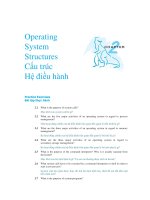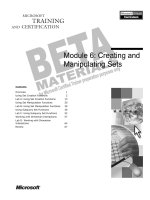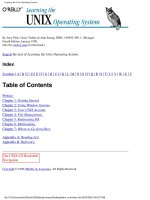Seminar 6: Creating an Embedded Operating System pot
Bạn đang xem bản rút gọn của tài liệu. Xem và tải ngay bản đầy đủ của tài liệu tại đây (398.27 KB, 38 trang )
COPYRIGHT © MICHAEL J. PONT, 2001-2006. Contains material from:
Pont, M.J. (2002) “Embedded C”, Addison-Wesley.
PES I - 139
Seminar 6:
Creating an Embedded
Operating System
Milk pasteurisation system
Milk pasteurisation system
Determine flow rate from pulse stream
COPYRIGHT © MICHAEL J. PONT, 2001-2006. Contains material from:
Pont, M.J. (2002) “Embedded C”, Addison-Wesley.
PES I - 140
Introduction
void main(void)
{
/* Prepare run function X */
X_Init();
while(1) /* 'for ever' (Super Loop) */
{
X(); /* Run function X */
}
}
A particular limitation with this architecture is that it is very
difficult to execute function X() at precise intervals of time: as we
will see, this is a very significant drawback.
For example …
COPYRIGHT © MICHAEL J. PONT, 2001-2006. Contains material from:
Pont, M.J. (2002) “Embedded C”, Addison-Wesley.
PES I - 141
“Item 345 was painted by Selvio Guaranteen early in the 16th century. At this time, Guaranteen,
who is generally known as a member of the Slafordic School, was …”
“Now turn to your left, and locate Item 346, a small painting which was until recently also
thought to have been painted by Guarateen but which is now …”.
Tim
e
Signal
level
Tim
e
Signal
level
(c
)
Samples = { 0.46, 0.42, 0.17, 0.04,
0.00, 0.13, 0.21, 0.53,
0.84, 0.89, 1.00, 1.00,
0.63, 0.42, 0.42, 0.21,
0.00, 0.11, 0.00, 0.42,
0.42, 0.23, 0.46, 0.42,
0.48, 0.52, 0.54, 0.57 }
(a)
(b
)
COPYRIGHT © MICHAEL J. PONT, 2001-2006. Contains material from:
Pont, M.J. (2002) “Embedded C”, Addison-Wesley.
PES I - 142
Consider a collection of requirements assembled from a range of
different embedded projects (in no particular order):
• The current speed of the vehicle must be measured at 0.5
second intervals.
• The display must be refreshed 40 times every second
• The calculated new throttle setting must be applied every 0.5
seconds.
• A time-frequency transform must be performed 20 times
every second.
• The engine vibration data must be sampled 1000 times per
second.
• The frequency-domain data must be classified 20 times every
second.
• The keypad must be scanned every 200 ms.
• The master (control) node must communicate with all other
nodes (sensor nodes and sounder nodes) once per second.
• The new throttle setting must be calculated every 0.5 seconds
• The sensors must be sampled once per second
In practice, many embedded systems must be able to support this
type of ‘periodic function’.
COPYRIGHT © MICHAEL J. PONT, 2001-2006. Contains material from:
Pont, M.J. (2002) “Embedded C”, Addison-Wesley.
PES I - 143
void main(void)
{
Init_System();
while(1) /* 'for ever' (Super Loop) */
{
X(); /* Call the function (10 ms duration) */
Delay_50ms(); /* Delay for 50 ms */
}
}
This will be fine, if:
1. We know the precise duration of function
X(), and,
2. This duration never varies.
COPYRIGHT © MICHAEL J. PONT, 2001-2006. Contains material from:
Pont, M.J. (2002) “Embedded C”, Addison-Wesley.
PES I - 144
Timer-based interrupts (the core of an embedded OS)
#define INTERRUPT_Timer_2_Overflow 5
void main(void)
{
Timer_2_Init(); /* Set up Timer 2 */
EA = 1; /* Globally enable interrupts */
while(1); /* An empty Super Loop */
}
void Timer_2_Init(void)
{
/* Timer 2 is configured as a 16-bit timer,
which is automatically reloaded when it overflows
This code (generic 8051/52) assumes a 12 MHz system osc.
The Timer 2 resolution is then 1.000 µs
Reload value is FC18 (hex) = 64536 (decimal)
Timer (16-bit) overflows when it reaches 65536 (decimal)
Thus, with these setting, timer will overflow every 1 ms */
T2CON = 0x04; /* Load T2 control register */
TH2 = 0xFC; /* Load T2 high byte */
RCAP2H = 0xFC; /* Load T2 reload capt. reg. high byte */
TL2 = 0x18; /* Load T2 low byte */
RCAP2L = 0x18; /* Load T2 reload capt. reg. low byte */
/* Timer 2 interrupt is enabled, and ISR will be called
whenever the timer overflows - see below. */
ET2 = 1;
/* Start Timer 2 running */
TR2 = 1;
}
void X(void) interrupt INTERRUPT_Timer_2_Overflow
{
/* This ISR is called every 1 ms */
/* Place required code here */
}
COPYRIGHT © MICHAEL J. PONT, 2001-2006. Contains material from:
Pont, M.J. (2002) “Embedded C”, Addison-Wesley.
PES I - 145
The interrupt service routine (ISR)
The interrupt generated by the overflow of Timer 2, invokes the
ISR:
/* */
void X(void) interrupt INTERRUPT_Timer_2_Overflow
{
/* This ISR is called every 1 ms */
/* Place required code here */
}
The link between this function and the timer overflow is made using
the Keil keyword interrupt:
void X(void) interrupt INTERRUPT_Timer_2_Overflow
…plus the following #define directive:
#define INTERRUPT_Timer_2_Overflow 5
Interrupt source Address IE Index
Power On Reset 0x00 -
External Interrupt 0 0x03 0
Timer 0 Overflow 0x0B 1
External Interrupt 1 0x13 2
Timer 1 Overflow 0x1B 3
UART Receive/Transmit 0x23 4
Timer 2 Overflow 0x2B 5
COPYRIGHT © MICHAEL J. PONT, 2001-2006. Contains material from:
Pont, M.J. (2002) “Embedded C”, Addison-Wesley.
PES I - 146
Automatic timer reloads
/* Preload values for 50 ms delay */
TH0 = 0x3C; /* Timer 0 initial value (High Byte) */
TL0 = 0xB0; /* Timer 0 initial value (Low Byte) */
TF0 = 0; /* Clear overflow flag */
TR0 = 1; /* Start timer 0 */
while (TF0 == 0); /* Loop until Timer 0 overflows (TF0 == 1) */
TR0 = 0; /* Stop Timer 0 */
For our operating system, we have slightly different requirements:
• We require a long series of interrupts, at precisely-
determined intervals.
• We would like to generate these interrupts without imposing
a significant load on the CPU.
Timer 2 matches these requirements precisely.
In this case, the timer is reloaded using the contents of the ‘capture’
registers (note that the names of these registers vary slightly
between chip manufacturers):
RCAP2H = 0xFC; /* Load T2 reload capt. reg. high byte */
RCAP2L = 0x18; /* Load T2 reload capt. reg. low byte */
This automatic reload facility ensures that the timer keeps
generating the required ticks, at precise 1 ms intervals, with very
little software load, and without any intervention from the user’s
program.
COPYRIGHT © MICHAEL J. PONT, 2001-2006. Contains material from:
Pont, M.J. (2002) “Embedded C”, Addison-Wesley.
PES I - 147
Introducing sEOS
void main(void)
{
Init_System();
while(1) /* 'for ever' (Super Loop) */
{
X(); /* Call the function (10 ms duration) */
Delay_50ms(); /* Delay for 50 ms */
}
}
In this case:
• We use a Super Loop and delay code
• We call X() every 60 ms - approximately.
Now let’s look at a better way of doing this …
COPYRIGHT © MICHAEL J. PONT, 2001-2006. Contains material from:
Pont, M.J. (2002) “Embedded C”, Addison-Wesley.
PES I - 148
Introducing sEOS
See “Embedded C”, Chapter 7
/* *-
Main.c (v1.00)
Demonstration of sEOS running a dummy task.
-* */
#include "Main.H"
#include "Port.H"
#include "Simple_EOS.H"
#include "X.H"
/* */
void main(void)
{
/* Prepare for dummy task */
X_Init();
/* Set up simple EOS (60 ms tick interval) */
sEOS_Init_Timer2(60);
while(1) /* Super Loop */
{
/* Enter idle mode to save power */
sEOS_Go_To_Sleep();
}
}
/* *-
END OF FILE
-* */
COPYRIGHT © MICHAEL J. PONT, 2001-2006. Contains material from:
Pont, M.J. (2002) “Embedded C”, Addison-Wesley.
PES I - 149
/* *-
Simple_EOS.C (v1.00)
Main file for Simple Embedded Operating System (sEOS).
Demonstration version with dummy task X().
-* */
#include "Main.H"
#include "Simple_EOS.H"
/* Header for dummy task */
#include "X.H"
/* *-
sEOS_ISR()
Invoked periodically by Timer 2 overflow:
see sEOS_Init_Timer2() for timing details.
-* */
sEOS_ISR() interrupt INTERRUPT_Timer_2_Overflow
{
/* Must manually reset the T2 flag */
TF2 = 0;
/*===== USER CODE - Begin ============================= */
/* Call dummy task here */
X();
/*===== USER CODE - End =============================== */
}
COPYRIGHT © MICHAEL J. PONT, 2001-2006. Contains material from:
Pont, M.J. (2002) “Embedded C”, Addison-Wesley.
PES I - 150
/* *-
sEOS_Init_Timer2()
-* */
void sEOS_Init_Timer2(const tByte TICK_MS)
{
tLong Inc;
tWord Reload_16;
tByte Reload_08H, Reload_08L;
/* Timer 2 is configured as a 16-bit timer,
which is automatically reloaded when it overflows */
T2CON = 0x04; /* Load T2 control register */
/* Number of timer increments required (max 65536) */
Inc = ((tLong)TICK_MS * (OSC_FREQ/1000)) /
(tLong)OSC_PER_INST;
/* 16-bit reload value */
Reload_16 = (tWord) (65536UL - Inc);
/* 8-bit reload values (High & Low) */
Reload_08H = (tByte)(Reload_16 / 256);
Reload_08L = (tByte)(Reload_16 % 256);
/* Used for manually checking timing (in simulator) */
/*P2 = Reload_08H; */
/*P3 = Reload_08L; */
TH2 = Reload_08H; /* Load T2 high byte */
RCAP2H = Reload_08H; /* Load T2 reload capt. reg h byte */
TL2 = Reload_08L; /* Load T2 low byte */
RCAP2L = Reload_08L; /* Load T2 reload capt. reg l byte */
/* Timer 2 interrupt is enabled, and ISR will be called
whenever the timer overflows. */
ET2 = 1;
/* Start Timer 2 running */
TR2 = 1;
EA = 1; /* Globally enable interrupts */
}
COPYRIGHT © MICHAEL J. PONT, 2001-2006. Contains material from:
Pont, M.J. (2002) “Embedded C”, Addison-Wesley.
PES I - 151
/* *-
sEOS_Go_To_Sleep()
This operating system enters 'idle mode' between clock ticks
to save power. The next clock tick will return processor
to the normal operating state.
-* */
void sEOS_Go_To_Sleep(void)
{
PCON |= 0x01; /* Enter idle mode (generic 8051 version) */
}
/* *-
END OF FILE
-* */
COPYRIGHT © MICHAEL J. PONT, 2001-2006. Contains material from:
Pont, M.J. (2002) “Embedded C”, Addison-Wesley.
PES I - 152
/* *-
X.C (v1.00)
Dummy task to introduce sEOS.
-* */
#include "X.H"
/* *-
X_Init()
Dummy task init function.
-* */
void X_Init(void)
{
/* Dummy task init */
}
/* *-
X()
Dummy task called from sEOS ISR.
-* */
void X(void)
{
/* Dummy task */
}
/* *-
END OF FILE
-* */
COPYRIGHT © MICHAEL J. PONT, 2001-2006. Contains material from:
Pont, M.J. (2002) “Embedded C”, Addison-Wesley.
PES I - 153
Tasks, functions and scheduling
• In discussions about embedded systems, you will frequently
hear and read about ‘task design’, ‘task execution times’ and
‘multi-tasking’ systems.
• In this context, the term ‘task’ is usually used to refer to a
function that is executed on a periodic basis.
• In the case of sEOS, the tasks will be implemented using
functions which are called from the timer-driven
interrupt service routine.
COPYRIGHT © MICHAEL J. PONT, 2001-2006. Contains material from:
Pont, M.J. (2002) “Embedded C”, Addison-Wesley.
PES I - 154
Setting the tick interval
In the function
main(), we can see that the control of the tick
interval has been largely automated:
/* Set up simple EOS (60 ms tick interval) */
sEOS_Init_Timer2(60);
In this example, a tick interval of 60 ms is used: this means that the
ISR (the ‘update’ function) at the heart of sEOS will be invoked
every 60 ms:
/* *-
sEOS_ISR()
Invoked periodically by Timer 2 overflow:
see sEOS_Init_Timer2() for timing details.
-* */
sEOS_ISR() interrupt INTERRUPT_Timer_2_Overflow
{
…
}
COPYRIGHT © MICHAEL J. PONT, 2001-2006. Contains material from:
Pont, M.J. (2002) “Embedded C”, Addison-Wesley.
PES I - 155
The ‘automatic’ tick interval control is achieved using the C pre-
processor, and the information included in the project header file
(Main.H):
/* Oscillator / resonator frequency (in Hz) e.g. (11059200UL) */
#define OSC_FREQ (12000000UL)
/* Number of oscillations per instruction (12, etc) */
#define OSC_PER_INST (12)
This information is then used to calculate the required timer reload
values in Simple_EOS.C as follows:
/* Number of timer increments required (max 65536) */
Inc = ((tLong)TICK_MS * (OSC_FREQ/1000)) / (tLong)OSC_PER_INST;
/* 16-bit reload value */
Reload_16 = (tWord) (65536UL - Inc);
/* 8-bit reload values (High & Low) */
Reload_08H = (tByte)(Reload_16 / 256);
Reload_08L = (tByte)(Reload_16 % 256);
…
TH2 = Reload_08H; /* Load T2 high byte */
RCAP2H = Reload_08H; /* Load T2 reload capt. reg h byte */
TL2 = Reload_08L; /* Load T2 low byte */
RCAP2L = Reload_08L; /* Load T2 reload capt. reg l byte */
COPYRIGHT © MICHAEL J. PONT, 2001-2006. Contains material from:
Pont, M.J. (2002) “Embedded C”, Addison-Wesley.
PES I - 156
• If using a 12 MHz oscillator, then accurate timing can
usually be obtained over a range of tick intervals from 1 ms
to 60 ms (approximately).
• If using other clock frequencies (e.g. 11.0592 MHz), precise
timing can only be obtained at a much more limited range of
tick intervals.
• If you are developing an application where precise timing is
required, you must check the timing calculations by hand.
/* Used for manually checking timing (in simulator) */
P2 = Reload_08H;
P3 = Reload_08L;
COPYRIGHT © MICHAEL J. PONT, 2001-2006. Contains material from:
Pont, M.J. (2002) “Embedded C”, Addison-Wesley.
PES I - 157
Saving power
Using sEOS, we can reduce the power consumption of the
application by having the processor enter idle mode when it finishes
executing the ISR.
This is achieved through the function
sEOS_Go_To_Sleep():
/* *-
sEOS_Go_To_Sleep()
This operating system enters 'idle mode' between clock ticks
to save power. The next clock tick will return processor
to the normal operating state.
-* */
void sEOS_Go_To_Sleep(void)
{
PCON |= 0x01; /* Enter idle mode (generic 8051 version) */
}
Note that the processor will automatically return to ‘Normal’ mode
when the timer next overflows (generating an interrupt).
Device Normal Idle Power Down
Atmel 89S53 11 mA 2 mA
60 µA
COPYRIGHT © MICHAEL J. PONT, 2001-2006. Contains material from:
Pont, M.J. (2002) “Embedded C”, Addison-Wesley.
PES I - 158
Using sEOS in your own projects
When using sEOS in your own applications, you will need to
include a copy of the files
Simple_EOS.C and Simple_EOS.H in your
project: the .C file will then need to be edited - in the area indicated
below - in order to match your requirements:
sEOS_ISR() interrupt INTERRUPT_Timer_2_Overflow
{
/* Must manually reset the T2 flag */
TF2 = 0;
/*===== USER CODE - Begin ============================= */
/* ADD YOUR FUNCTION (TASK) CALLS HERE */
/*===== USER CODE - End =============================== */
}
COPYRIGHT © MICHAEL J. PONT, 2001-2006. Contains material from:
Pont, M.J. (2002) “Embedded C”, Addison-Wesley.
PES I - 159
Is this approach portable?
• The presence of an on-chip timer which can be used to
generate interrupts in this way is by no means restricted to
the 8051 family: almost all processors intended for use in
embedded applications have timers which can be used in a
manner very similar to that described here.
• For example, similar timers are included on other 8-bit
microcontrollers (e.g. Microchip PIC family, the Motorola
HC08 family), and also on 16-bit devices (e.g. the Infineon
C167 family) as well as on 32-bit processors (e.g. the ARM
family, the Motorola MPC500 family).
COPYRIGHT © MICHAEL J. PONT, 2001-2006. Contains material from:
Pont, M.J. (2002) “Embedded C”, Addison-Wesley.
PES I - 160
Example: Milk pasteurization
Milk pasteurisation system
Milk pasteurisation system
Determine flow rate from pulse stream
COPYRIGHT © MICHAEL J. PONT, 2001-2006. Contains material from:
Pont, M.J. (2002) “Embedded C”, Addison-Wesley.
PES I - 161
/* *-
Port.H (v1.00)
Port Header file for the milk pasteurization example
(“Embedded C” Chapter 7)
-* */
/* Pulse_Count.C */
/* Connect pulse input to this pin - debounced in software */
sbit Sw_pin = P3^0;
/* Connect alarm to this pin (set if pulse is below threshold) */
sbit Alarm_pin = P3^7;
/* Bargraph.C */
/* Bargraph display on these pins (the 8 port pins may be
distributed over several ports, if required). */
sbit Pin0 = P1^0;
sbit Pin1 = P1^1;
sbit Pin2 = P1^2;
sbit Pin3 = P1^3;
sbit Pin4 = P1^4;
sbit Pin5 = P1^5;
sbit Pin6 = P1^6;
sbit Pin7 = P1^7;
/* *-
END OF FILE
-* */
COPYRIGHT © MICHAEL J. PONT, 2001-2006. Contains material from:
Pont, M.J. (2002) “Embedded C”, Addison-Wesley.
PES I - 162
/* *-
Main.c (v1.00)
Milk pasteurization example.
-* */
#include "Main.H"
#include "Port.H"
#include "Simple_EOS.H"
#include "Bargraph.H"
#include "Pulse_Count.H"
/* */
void main(void)
{
PULSE_COUNT_Init();
BARGRAPH_Init();
/* Set up simple EOS (30ms tick interval) */
sEOS_Init_Timer2(30);
while(1) /* Super Loop */
{
/* Enter idle mode to save power */
sEOS_Go_To_Sleep();
}
}
/* *-
END OF FILE
-* */
COPYRIGHT © MICHAEL J. PONT, 2001-2006. Contains material from:
Pont, M.J. (2002) “Embedded C”, Addison-Wesley.
PES I - 163
/* *-
Simple_EOS.C (v1.00)
Main file for Simple Embedded Operating System (sEOS) for 8051.
This version for milk-flow-rate monitoring.
-* */
#include "Main.H"
#include "Simple_EOS.H"
#include "Pulse_count.H"
/* *-
sEOS_ISR()
Invoked periodically by Timer 2 overflow:
see sEOS_Init_Timer2() for timing details.
-* */
sEOS_ISR() interrupt INTERRUPT_Timer_2_Overflow
{
/* Must manually reset the T2 flag */
TF2 = 0;
/*===== USER CODE - Begin ================================== */
/* Call 'Update' function here */
PULSE_COUNT_Update();
/*===== USER CODE - End ==================================== */
}









